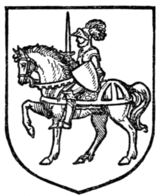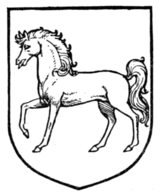The horse will be found rampant (or forcene, or salient) (Fig. 360), and will be found courant (Fig. 361), passant (Fig. 362), and trotting.
When it is "comparisoned" or "furnished" it is shown with saddle and bridle and all appurtenances; but if the saddle is not present it would only be blazoned "bridled."
"Gules, a horse argent," really the arms of Westphalia, is popularly known in this country as the coat of Hanover, inasmuch as it was the most prominent charge upon the inescutcheon or quartering of Hanover formerly borne with the Royal Arms. Every one in this country is familiar with the expression, "the white horse of Hanover."
Horses will also be found in many cases as supporters, and these will be referred to in the chapter upon that subject, but reference should be particularly made here to the crest of the family of Lane, of King's Bromley, which is a strawberry roan horse, couped at the flanks, bridled, saddled, and holding in its feet the Imperial crown proper. This commemorates the heroic action of Mistress Jane Lane, afterwards Lady Fisher, and the sister of Sir Thomas Lane, of King's Bromley, who, after the battle of Worcester and when King Charles was in hiding, rode from Staffordshire to the south coast upon a strawberry roan horse, with King Charles as her serving-man. For this the Lane family were first of all granted the canton of England as an augmentation to their arms, and shortly afterwards this crest of the demi-horse (Plate II.).
The arms of Trevelyan afford an interesting example of a horse, being: "Gules, issuant out of water in base proper, a demi-horse argent, hoofed and maned or."
The heads of horses are either so described or (and more usually) termed "nags' heads," though what the difference may be is beyond




